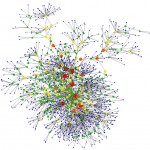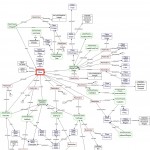Have you ever wondered what happens when an English learner reads and listens? I have. I know they acquire more English when they read and listen to understandable English … more vocabulary … more grammatical concepts … more of almost everything they need to improve their fluency. But what actually happens inside the brain? What does it look like?
We don’t know for sure. But there’s enough evidence, from psycholinguistics and neural research, to allow us to make some reasonable guesses. What follows is a short trip of fantasy. But even though it’s fantasy, it’s probably more truth than fiction.
In our minds, there’s a wonderful, complex (consisting of many different and connected parts), multi-dimensional language map. Let’s imagine that it looks something like this (click to make larger):
Now, imagine that the colored dots represent various language elements – orange for vocabulary and yellow for grammar concepts. The larger ones have been around longer, they’re older. They’ve seen more. And heard more. As a result, they’re stronger and better developed than the smaller ones.
The lines that connect the elements suggests relationships – one element following another, depending on it, always appearing with it, being related somehow in meaning or function (activity or purpose).
If we zoom in and look closely at only one element – let’s try the word “wine” – it might look something like this (click to make larger):
Wow! Look at all the connections from that one word!
Imagine that multiplied thousands of times for every bit of vocabulary. For every grammatical idea. For every language element needed for fluency. Imagine trying to teach that one concept at a time!
Let’s get back to the big question: what happens when a language student reads and listens to something they understand?
As we read, we try to make sense of, or understand, what we’re reading. Or listening to. Our mind reaches back into our language map and tries to make connections with language it has already acquired. It uses our existing language, our understanding of what we’re reading, and our life experience, to make sense of what we’re reading. And as it does, amazing things happen. Existing elements and connections are strengthened. New connections and elements are added. The map becomes more robust (strong and healthy), more complex, and our fluency increases.
I frequently watch my students read. I imagine that I can see and hear the connections taking place. Every word, every sentence, every paragraph they read feeds that wonderful language acquisition device that works constantly – when fed properly – to produce more language. Automatically. Subconsciously. Naturally. Just the way it was designed to work.


